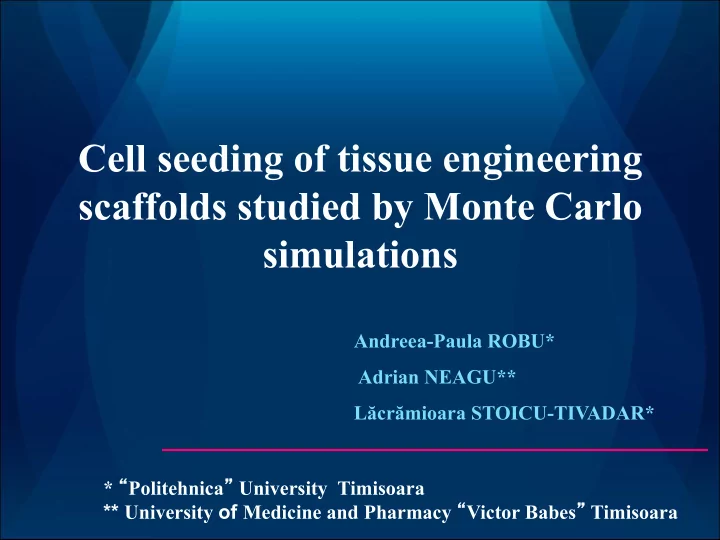

Cell seeding of tissue engineering scaffolds studied by Monte Carlo simulations Andreea-Paula ROBU* Adrian NEAGU** L ă cr ă mioara STOICU-TIVADAR* * “ Politehnica ” University Timisoara ** University of Medicine and Pharmacy “ Victor Babes ” Timisoara
Contents • Tissue Engineering • The Differential Adhesion Hypothesis • A computational model of a multi-cellular system • The simulation algorithm • Cell seeding simulations of a porous scaffold • Identification of energetic and geometric conditions for optimal cell seeding • Conclusions
Tissue Engineering • A new field of biomedical research • Aims to create therapeutic constructs in vitro that can be implanted in the human body
Methods of tissue engineering • Culturing living cells on a porous scaffold • The scaffold gradually disappears, while the cells continue to develop
Cell rearrangements described by DAH Steinberg ’ s differential adhesion hypothesis (DAH) states that: • Cells move to form the largest number of strong connections with their neighbors Cells tend to reach the minimum energy configuration • Cells use their motility to achieve the desired configuration
Molecular basis of cell adhesivity The macromolecules involved in the processes of tissue rearrangement are: • cadherins - intercellular adhesion molecules • integrins - substrate adhesion molecules • The cohesion forces that act at cell interaction, respectively the adhesion forces that act at the interaction between cells and substrate are transmitted through these molecules.
Goals • Build a computational model of tissue constructs • Study cell seeding of porous scaffolds • Identify the optimal conditions that lead to an uniform and rapid distribution of cells in the scaffold
Computational model • System: cell suspension located near a porous scaffold, bathed in culture medium • The 3D computational model is built on a cubic lattice: each site of the lattice is occupied by either a cell or medium or biomaterial • The porosity of the scaffold is achieved in the model by taking into account the radius of the pores as well as the radius of the circular orifices that connect the pores
Model visualization
P min 1,exp( ( E E / ) ) = −Δ T Computational algorithm Metropolis Monte Carlo • An elementary move = swap of a cell with a volume element of cell culture medium from its vicinity • A move is accepted with a probability : • A Monte Carlo step (MCS) is represented by the sequence of operations in which each cell is given the chance to make a move
Energy of adhesion E B * B * = γ + γ cs cs cm cm - The cell-medium interfacial tension parameter: 1 γ = ε cm cc 2 - The cell-substrate interfacial tension parameter: 1 γ = 2 ε − ε cs cc cs
Input and output parameters • Input parameters: - cohesion energy between cells - adhesion energy between cells and scaffold - radius of pores - radius of circular orifices that connect the pores • Output parameters: - centre of mass of all cells - centre of mass of seeded cells - concentration of the cells remained in suspension
Simulation parameters Values of input and output parameters in representative simulations z E ε CM cs T
The centre of mass of all cells The centre of mass of seeded cells - Simulation I The image cannot be displayed. Your computer may not have enough memory to open the image, or the image may have been corrupted. Restart your computer, and then open the file again. If the red x still appears, you may have to delete the image and then insert it again.
The fraction of the cells outside the scaffold - Simulation I
Simulation I If the cells do not adhere to each other, but they adhere to the scaffold, the seeding is rapid and cell distribution in the scaffold is uniform Configuration after 80 000 MCS ε cc=0, ε cs=0.6, R=5, r=2
The centre of mass of all cells The centre of mass of seeded cells - Simulation II
The fraction of the cells outside the scaffold - Simulation II
Simulation II • If the cell-cell interaction energy is nonzero, but small enough to ensure a negative cell-scaffold interfacial tension, uniform distribution is reached, but the process is slower • For a cell-cell interaction energy of 0.8, cell aggregates emerge and the penetration of cells into the scaffold is slower Configuration after 80 000 MCS ε cc=0.8, ε cs=0.6, R=5, r=2
The centre of mass of all cells The centre of mass of seeded cells - Simulation III
The fraction of the cells outside the scaffold - Simulation III
Simulation III Seeding is severely hampered if the cell-cell interaction energy is larger than twice the cell- substrate interaction energy, making the cell- scaffold interfacial tension positive Configuration after 80 000 MCS ε cc=1, ε cs=0.25, R=5, r=2
Simulation IV If the orifices that connect the pores are large (exceeding half of the pore’s diameter), the scaffold is not contiguous and does not offer enough biomaterial to be attached to. Configuration after 80 000 MCS ε cc=0, ε cs=0.6, R=8, r=5
Conclusions • We developed a computational model of a cell suspension located on the surface of a porous scaffold • Using the Metropolis Monte Carlo method, we simulated the cell seeding process for different values of the cell-cell, and cell- scaffold interaction energy, and for different geometries of the scaffold
Conclusions • Our simulations show clearly that the emergent configuration is a result of a tug-of-war between cell-cell and cell-substrate interaction • This study enables the optimisation of the cell seeding • Simulations of cell seeding are useful for testing different experimental conditions, which in practice would be very expensive and hard to perform
Future Developments cell proliferation Model cell death process scaffold degradation
Thank you for your attention! Takk for oppmerksomheten! andreea.robu@aut.upt.ro
Recommend
More recommend